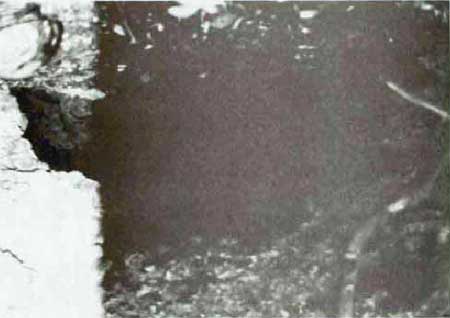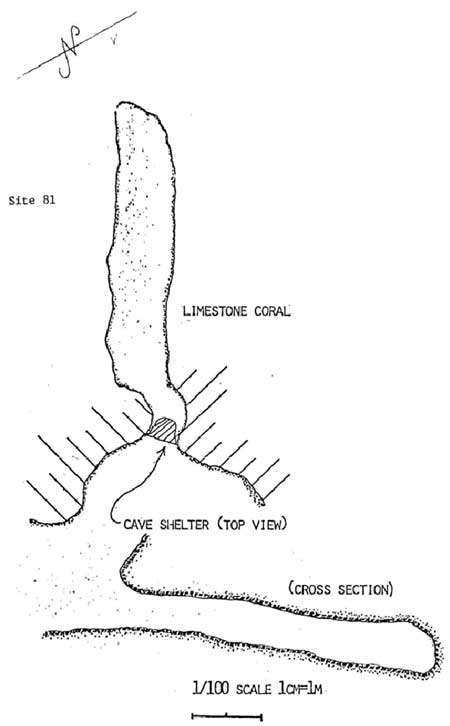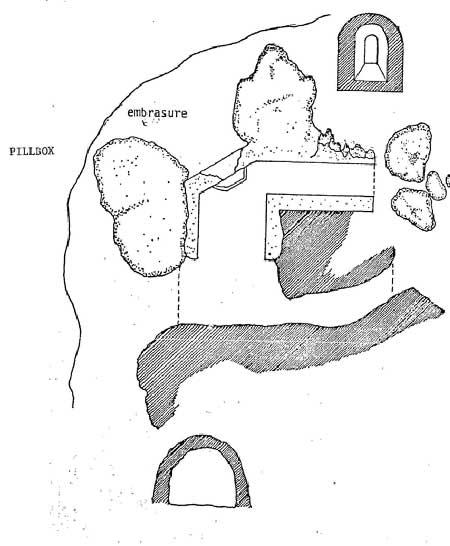War in the Pacific
Historic Resource Study
|

|
D. Agat Unit and Mt. Alifan Unit
I. Agat Unit (continued)
Bangi Point and Bangi Island
Although within the boundaries of the park, the historic resources at
Bangi are presently privately owned. Bangi Island may be reached by
wading the shallow water from Bangi Point. Also, it is possible to wade
around the island, even at high tide--providing the water is calm. Large
coastal guns on Bangi island flanked the 4th U.S. Marines' landing on
Beaches White 1 and 2.
No. 10. Japanese pillbox. Like No. 9 above, this reinforced-concrete
pillbox on Bangi Point has two embrasures for covering the beaches to
the north and south. There is also a rifle slit on the west side which
faces Bangi island.

|
|
No. 10. Japanese pillbox, Bangi Point, Agat.
|
No. 80. Japanese coastal gun emplacements. At the time of the
American invasion, the Japanese had two 20cm (8-inch), short-barrel guns
emplaced on the north side of Bangi Island. The reinforced-concrete
pillboxes to protect the guns Ware. still under construction. Two
unfinished conrete walls remain standing.

|
|
No. 80. Japanese 20cm gun, Bangi Island, October 1944.
|

|
|
No. 80. Japanese 20cm gun, Bangi Island, October 1944.
|

|
|
No. 80. Japanese 20cm gun emplacement, Bangi Island, 1984.
|

|
|
No. 80. Japanese 20cm gun emplacement, Bangi Island, 1984.
|

|
|
No. 80. Japanese gun emplacement, Bangi Island, Agat.
|
No. 81. Japanese cave. It is on Bangi Island adjacent to No. 80,
above. Probably used for storage or a personnel shelter.

|
|
No. 81. Japanese cave, Bangi Island, 1984.
|

|
|
No. 81. Japanese cave, Bangi Island, Agat.
|
No. 82. Japanese cave. It is on Bangi Island in the cliff directly
above No. 83, below.

|
|
No. 82. Japanese cave, Bangi Island, 1984.
|
No. 83. Japanese pillbox. It is so sited on Bangi Island as to cover
beaches to the south; thus, it played no direct role during the American
invasion. Here, the Japanese took advantage of holes in the limestone
cliff and added a reinforced-concrete wall with an embrasure to the
front. Two tunnels, each lined with concrete, lead into the gun
emplacement. The more easterly tunnel is in relatively good condition;
the other, exposed to storms, is more fragile. Rock rubble has fallen
into both tunnels and into the pillbox. The gun embrasure is placed so
low to the high-tide water level, that water occasionally enters. The
Japanese, however, provided a drain. Although not tacticalty important
during the American landings, the pillbox's engineering is of sufficient
interest for it to be included in an interpretive program.

|
|
No. 83. Japanese pillbox, Bangi Island, 1984.
|

|
|
No. 83. Japanese pillbox tunnels, Bangi Island, 1984.
|

|
|
No. 83. Japanese pillbox tunnels, Bangi Island, 1984.
|

|
|
No. 83. Japanese pillbox, Bangi Island, Agat.
|
No. 104. Aluton Island. It is off Bangi Point and within the national
park boundaries. It was occupied by the 4th U.S. Marines who found it
undefended.
No. 105. Yona Island. Also off Bangi Point and within the park
boundaries, Yona Island had a Japanese 75mm field piece which, in
conjunction with the 75mm guns on Gaan Point, placed a crossfire on
American landing craft, sinking 20 of them. A recent survey of Yona
Island failed to disclose a gun emplacement.
wapa/hrs/hrsd1c.htm
Last Updated: 07-Mar-2005
|













